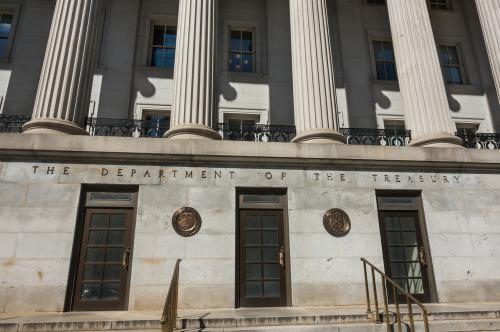This post was updated on October 25, 2017 to reflect a bill passed by Congress that partially forgives some of the program’s debt.
The recent devastating hurricanes have, once again, focused attention on the National Flood Insurance Program, long a subject of controversy and concern. The program was to expire on September 30, but Congress recently extended it until December 8, 2017. Here are the basics on the program and the challenges it faces.
What is the National Flood Insurance Program?
NFIP is a federally subsidized program that enables homeowners, businesses, and renters in participating communities to insure their property against flood damage. The program is administered by the Federal Emergency Management Agency (FEMA).
The original objectives of the NFIP were to constrict unwise floodplain development, to ensure that property owners could receive coverage at a reasonable cost, to get a large number of communities and property owners to buy insurance, and to base premiums on federal assessments of flooding risk so people would be aware of and bear the cost of choices they make.
NFIP has three main components:
- Hazard identification and mapping: NFIP conducts engineering studies and constructs flood maps to assess flood risk.
- Floodplain management criteria and mitigation: NFIP establishes minimum structural requirements for buildings within certain flood hazard areas. For example, it requires “substantially damaged” properties (receiving claims worth half their value) in high-risk areas to relocate or elevate. In some circumstances, the program can also provide funding for mitigating a building’s flood risk.
- Flood insurance: Participating communities must agree to adopt NFIP regulations. Most NFIP insurance policies are sold and serviced by private insurers under FEMA’s Write Your Own program. However, these companies primarily serve an administrative function, and thus do not bear the risks associated with paying claims.
The program attempts to do more than a traditional insurance program. It is meant to be a comprehensive national flood risk management program, with components of insurance, risk assessment, flood hazard mitigation, and community-level land use and building code requirements aimed at reducing and managing flood risks into the future.
Why is the federal government in this business?
Congress created the NFIP in 1968 after a series of hurricane-induced disasters. At the time, escalating costs of repairing flood damage and adverse selection (the likelihood that people who expect losses are more likely to buy insurance than those who don’t expect losses) made it difficult for private companies to offer affordable flood insurance, and most homeowner insurance providers eliminated flood coverage from their policies. Existing disaster assistance programs provided some federal support only if a flood was officially declared to be a major disaster. The basic bargain was that the federal government would make insurance available only within communities that adopted and enforced ordinances to manage development in floodplains. Currently, some 22,000 U.S. communities, the vast majority, participate in the NFIP.
How much does flood insurance cost for a typical household? How is that cost determined?
The Congressional Budget Office (CBO) reports that the median premium for residential coverage in 2016 was about $520 per year, with most of the premiums between $420 and $1,330. A 2011 report by the Property Casualty Insurers Association of America estimated that the premiums households pay are on average about half of what the private market would charge; in high risk areas, premiums are about one-third of that. Premiums are based on a variety of factors—including the flooding risk of the area in which a property is located, the year a property was built, the timing of a community’s flood map update, and the status of nearby flood-control structures—and, in many instances, are reduced by subsidies and other program rules.
How many properties are covered?
As of 2016, there were over 5 million policies across the U.S., 95 percent of which were residential. Properties in high-risk areas that have mortgages from federally regulated lenders are required to have flood insurance that covers the lesser of the outstanding mortgage or $250,000. As a result, those who are more likely to make claims are more likely to buy insurance than those who are less likely to make claims (adverse selection). CBO estimates that 47 percent of NFIP’s policies are in high risk zones, and 32 percent are not (the CBO could not classify 21 percent of the policies). Take-up rates are estimated to be around 50 percent in coastal areas but much lower inland. Five states—Florida (35 percent), Texas (12 percent), Louisiana (9 percent), California (6 percent), and New Jersey (4.5 percent)—account for about two thirds of all policies in the program .
What does the NFIP consider a high-risk area?
A high-risk zone—also known as a 100-year floodplain—is an area where there is a 1 percent probability of flooding in any given year. This does not mean that an area will flood only once in every hundred years, though. Indeed, a house with a 30-year mortgage in a 100-year floodplain has more than a 25 percent chance of being flooded during those 30 years.
Is the take-up requirement enforced?
The federal agencies responsible for enforcing the mandatory purchase of flood insurance have found it difficult to enforce their rules implementing federal law in this area. In 2015, FEMA estimated that as few of half of the 1.5 million residential buildings that are required to have flood insurance actually do. Reports have concluded that many homeowners are not adequately insured, or insured at all.
Mortgage lenders are responsible for checking which homes are in flood plains, and require those owners to get insurance. When these mortgages are sold to investors, the servicing company is responsible for making sure the premiums are paid. However, it seems that homeowners typically pay premiums for only two to four years after a closing or a flood. Since 2012, the Comptroller of the Currency has fined at least 27 institutions for failing to meet their flood insurance obligations. However, lax lenders and servicers usual are penalized lightly, often fined only a few thousand dollars.
How does the Congressional Budget Office score NFIP?
CBO makes 10-year baseline forecasts of annual spending and income for NFIP, assuming that the program will continue to operate as specified under current law. This baseline estimate considers factors affecting costs and premiums that are likely to change over time, such as changes in the composition of insured properties, and changes to FEMA’s rate setting methods. The baseline relies on FEMA’s estimates of expected claims. For the 2018-2027 period, CBO projects that income will fall short of costs by about $1 billion each year. These projections were made before Hurricane Harvey and Hurricane Irma.
CBO also made one-year projections of revenues and costs for the 5 million policies in place on August 31, 2016. Consistent with the 10-year baseline, the one-year projection also indicates program shortfalls. For this fiscal year, CBO estimates claims and administrative costs of $5.7 billion and revenues of $4.3 billion, leaving a $1.4 billion shortfall. The actuarial shortfall, which measures the adequacy of collected premiums to cover claims and administrative costs, is $700 million. The actuarial shortfall excludes additional NFIP costs such as mapping, building mitigation, and interest on debt.
NFIP is currently $25 billion in debt. How come?
When NFIP cannot cover its costs, it borrows from the Treasury—that is, from the taxpayers. The idea was that the program would borrow in years with lots of claims and pay back the loans in years with fewer claims. That worked for a while, until Hurricane Katrina in 2005, when there were an unprecedented number of claims. Since 2005, the NFIP has borrowed about $24.9 billion. Under current law, the program can borrow up to $30.4 billion. Anything above that will need congressional approval.
On October 24, 2017, Congress passed a disaster relief package that forgives $16 billion of NFIP’s debt— the projected losses of this year’s hurricanes.
Why don’t premiums cover costs?
The simple answer is that premiums are too low, given the risks that the program takes. This mismatch reflects political resistance against premiums that actually reflect flooding risks, flawed mapping methods that don’t accurately assess flood risks, lax enforcement of program rules, and the cycle of rebuilding damaged properties with NFIP payouts (often without risk mitigation such as relocations, removals or building elevations), only to be flooded again. Further, obsolete FEMA flood-risk maps tend to distort premiums, hinder property relocation to safer areas, and obscure the risk of flood-prone areas from consumers. NFIP “grandfathering” practices allow property owners to follow rules based on older versions of FEMA flood maps. For example, buildings constructed in compliance with previous flood ratings are not required to update their structural requirements, even if new classifications indicate greater flooding risk. Structures that haven’t been updated to reflect higher flood risks tend to have more damage when disasters strike. These grandfathered properties may also receive special subsidies that reduce their premiums further.
How successful is NFIP at constricting property development on flood-prone areas?
Although stricter floodplain management criteria were intended to discourage development in flood-prone areas, the program sometimes does the opposite. Low insurance premiums in high-risk areas do not accurately reflect risk to property buyers, and they reduce incentives to relocate to lower-risk areas. Consequently, an increasingly large amount of NFIP’s financial drain comes from “repetitive loss properties”— properties for which there have been two or more claims of over $1,000 in any 10-year period since 1978. As of 2014, repetitive loss properties accounted for 1 percent of policies, but represented 25 percent to 30 percent of all claims. Since the program’s implementation in 1968, repetitive loss properties have cost NFIP $12.5 billion.
Additionally, many communities seek to “protect” high-risk areas with structural projects such as dams, levees, or floodwalls. The structures can promote a false sense of security and facilitate development in risky areas. Communities may be motivated to build these protective structures because they can waive the NFIP “mandatory insurance purchase” requirement for residents. Thus, when the protective structures collapse during large storms, large numbers of residents have no flood insurance and suffer catastrophic levels of flood damages and losses.
Does NFIP affect people differently based on region? Income?
Areas on the coasts of the U.S. are more prone to flood damage than inland locations. CBO estimates that costs exceeded premiums in coastal counties by $1.5 billion, while inland counties generated a small surplus of $200 million. Policies in coastal counties accounted for more than 75 percent of expected claims, but represented only 10 percent of all counties with NFIP policies. The CBO attributes this difference partially to two main factors: NFIP’s rules for subsidies (set by law or by FEMA) and FEMA’s rate-setting system. Subsidies mostly go to coastal counties, and larger expected costs associated with coastal counties are reflected in higher premiums for inland counties.
The program does not use income to determine eligibility or to set premiums, and better-off homeowners appear more likely to take buy coverage. As of 2012, about 80 percent of NFIP’s subsidized housing units were in counties with median incomes in the top quintile. Forty-two percent of NFIP properties had the maximum $250,000 in coverage, suggesting that covered properties are of higher than average value. A 2007 paper by the CBO found that 25 percent of explicitly subsidized coastal NFIP properties are vacation homes.
What has happened to attempts to change NFIP?
Attempts to reform NFIP essentially reflect the struggle to balance two conflicting goals: keeping the program financially sound and keeping insurance affordable. Actuarially sound rates would communicate flood risk to homeowners and contribute to the program’s financial sustainability, but could result in higher premiums that depress property values and lead to lower program participation. On the other hand, keeping rates affordable could protect participants from financial hardship, but may detract from the program’s sustainability.
Environmentalists, taxpayer groups, and other reformers have pushed to raise premiums to better reflect flood risks and limit repetitive loss payments. The bipartisan Biggert-Waters Flood Insurance Reform Act of 2012 was an attempt to address financial sustainability. It called for aligning policyholders’ premiums with actual flood risks by removing or accelerating the phase-out of discounted rates. It also eliminated special subsidies for high-risk properties built before FEMA’s flood maps were constructed, and eliminated many grandfathering practices.
However, there was pushback from real estate agents, homebuilders, developers and politicians representing flood-prone areas. After the 2012 law was passed, Congress received numerous complaints that it would result in unaffordable premiums. Some news articles reported that premium increases could be in the thousands of dollars per year, and many argued that sharp premium increases would be unfair because households make financial plans based on expected insurance premiums. There was also concern that higher premiums would depress housing values and business profitability, and discourage people from participating in NFIP. The outcry resulted in passage of Homeowner Flood Insurance Affordability Act in 2014, which slowed or reversed many of the changes that the 2012 law called for.
Now what?
With NFIP’s legal authorization extended until December 8, 2017, Congress has an opportunity to make some reforms.
In June, the House Financial Services Committee passed a package of bills, pushed by Chairman Jeb Hensarling (R-TX). The bill package would renew the program for five years, make coverage more expensive for policyholders, and make it easier for private companies to sell their own flood insurance policies. However, there has been opposition to Hensarling’s proposals. In late July, a handful of members from his own party sent a letter to Speaker Paul Ryan, stating that they could not support the policies due to affordability concerns (some Democrats also echoed these concerns). “[M]any believe everyone’s rates should go up just to make sure it can fund outlier events like Hurricane Katrina,” said Rep. Steven Palazzo, one of the members who signed the letter. “I will not let this happen.” Henarsling’s committee responded to the pushback by dialing back proposed fee and rate increases, and eliminating the provision that addressed grandfathering practices. “The idea is you compromise your policies in order to advance your principles,” says Hensarling.
In late September, a coalition of flood-state Representatives, Senators, and Democratic leaders twice defeated attempts by Hensarling and House Republican leadership to move private flood insurance incentives separately from comprehensive flood insurance legislation. The Senate, in particular, appears resolved only consider privatization issues in the context of a comprehensive reauthorization.
Other proposals and directions are in the works as well. A bipartisan group of House and Senate members—including Reps. Clay Higgins (R-LA), Mike Johnson (R-LA), Bonnie Watson Coleman (D-NJ), Gregg Harper (R-MS), and Sens. Bob Menendez (D-NJ), John Kennedy (R-LA), Thad Cochran (R-LA), Marco Rubio (R-FL), Bill Nelson (D-FL), Elizabeth Warren (D-MA), Cory Booker (D-NJ)—are backing a bill they call the Sustainable, Affordable, Fair and Efficient (SAFE) NFIP Reauthorization Act. This bill focuses more on affordability, as well as greater investments in flood risk mapping and risk mitigation. It would reauthorize NFIP for six years, cap all premium hikes at 10 percent, increase policy coverage limits, and freeze interest payments on its debt. Addressing Hensarling’s efforts, Louisiana Sen. Kennedy states, “I don’t want to see him stabilize it and then have nobody able to afford the insurance…[O]ur bill tries to strike a balance between stability in the program yet still making it actually available to the people who need it“.
Sens. Bill Cassidy (R-LA) and Kirsten Gillibrand (D-NY) have also introduced the Flood Insurance Affordability and Sustainability Act of 2017. Some of their provisions include reauthorizing NFIP over a 10-year term, encouraging privatization, and providing affordability vouchers for premiums.
Exactly which reforms will pass remains largely uncertain, but one thing is apparent: Thus far, the rigid partisan division that has been so characteristic of the health care and tax reform debates seems to be less pronounced in the flood insurance discussion.
For more on the National Flood Insurance Program, see:
Reforming Federal Support for Risky Development
David Conrad and Edward Thomas; The Hamilton Project (2013)
The National Flood Insurance Program: Financial Soundness and Affordability
CBO report (2017)
Affordability of the National Flood Insurance Program Premiums
Committee on the Affordability of National Flood Insurance Program Premiums, Water Science and Technology Board–Division on Earth and Life Studies, Board on Mathematical Sciences and Their Applications–Division on Engineering and Physical Sciences, Committee on National Statistics–Division on Behavioral and Social Sciences and Education, and the National Research Council (2015)
How Will We Pay for Superstorm Sandy?
Jaison R. Abel, Jason Bram, Richard Deitz, and James Orr; Federal Reserve Bank of New York (2012)







Commentary
The Hutchins Center Explains: National Flood Insurance Program
October 10, 2017